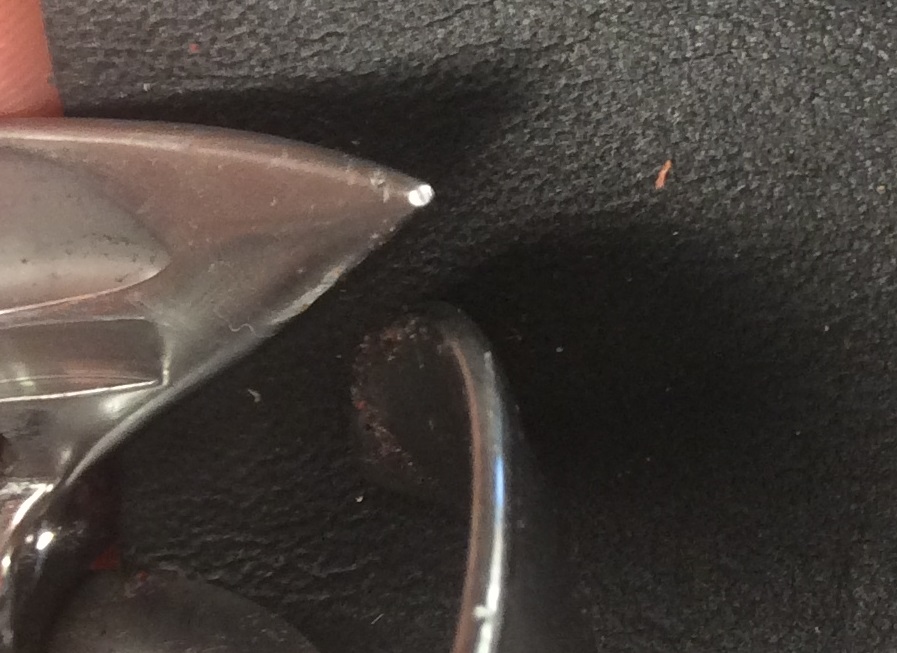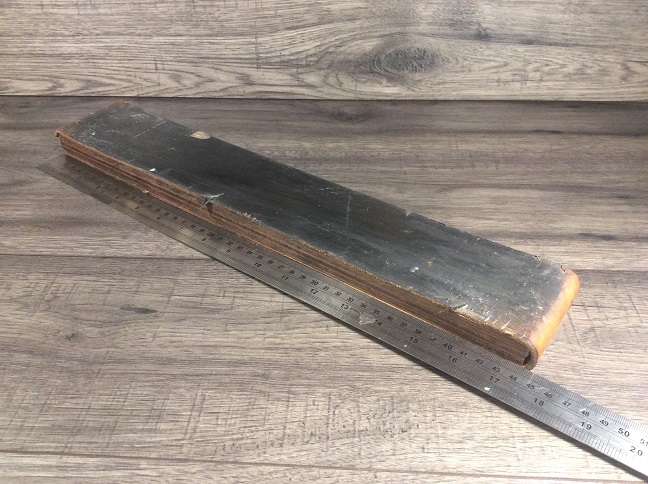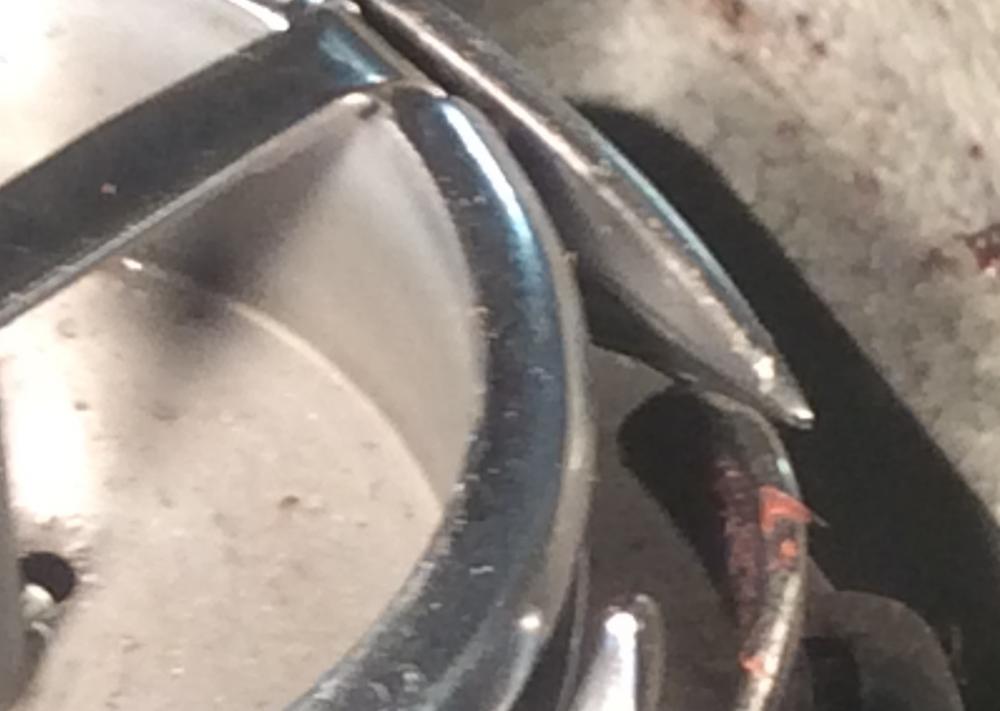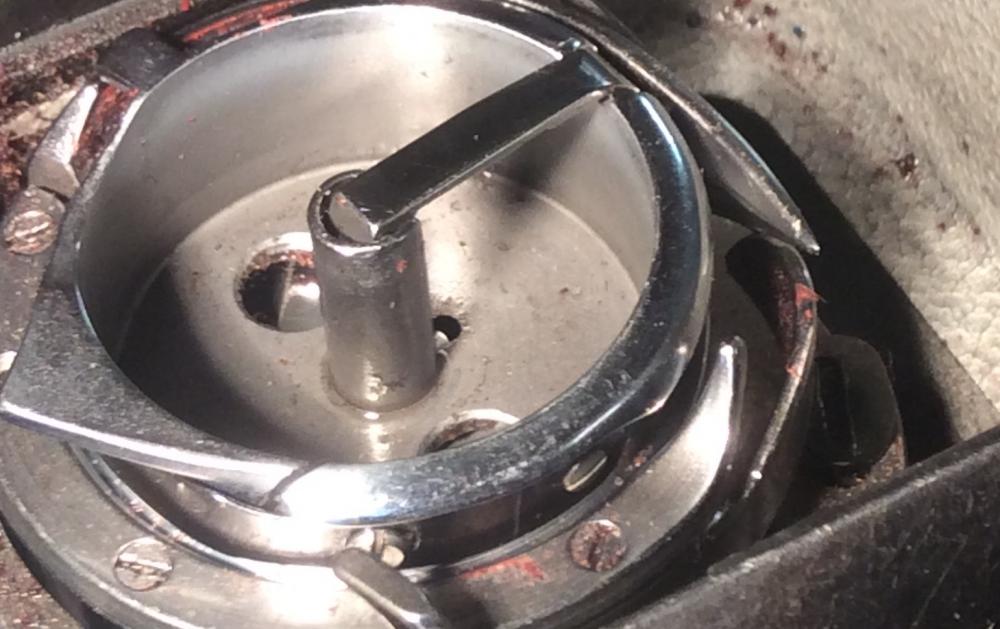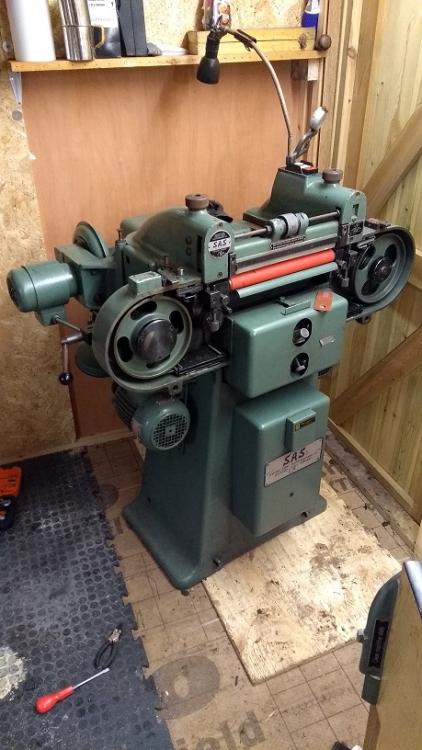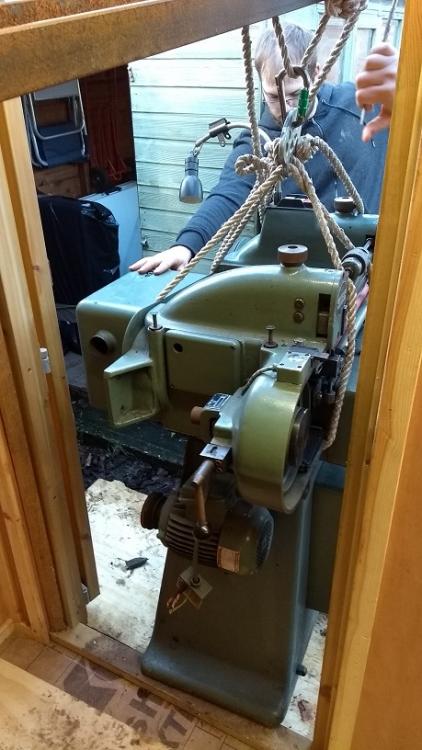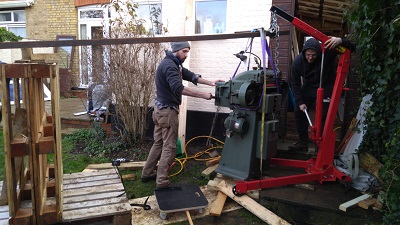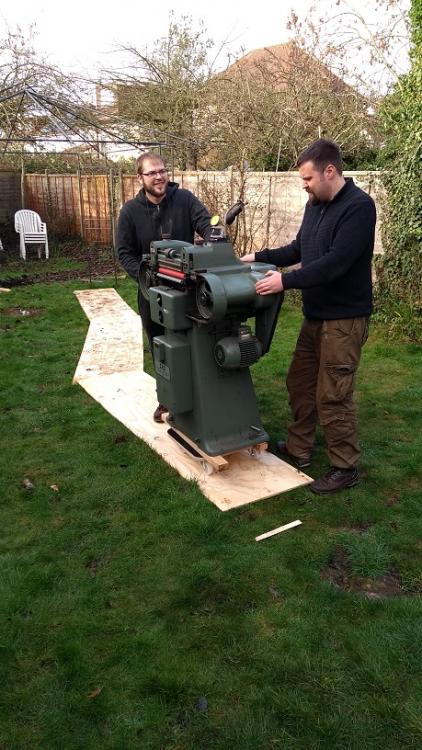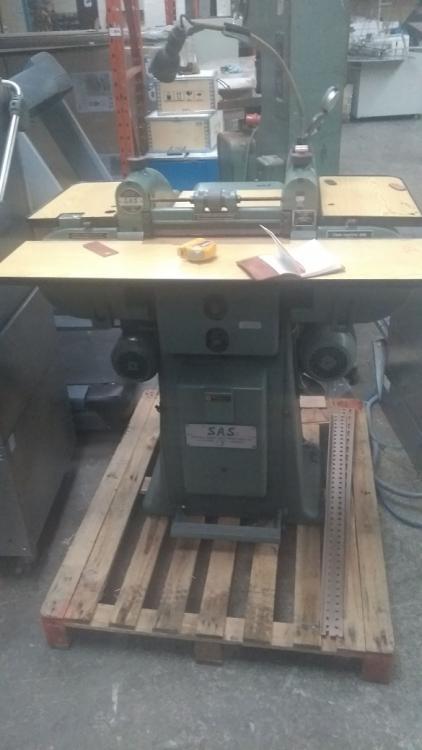-
Posts
1,806 -
Joined
Content Type
Profiles
Forums
Events
Blogs
Gallery
Everything posted by Matt S
-
Normally I'd agree with you, but I think there's now a severe angle change that needs severe correction. I've pulled the hook, hopefully these photos are a little clearer. I'm no photographer. As can be seen the angle of the tip now changes very abruptly at the point, which also exhibits a flat shiny spot on the very end. This makes me think that the point has gone, possibly shortening the hook. There's a slight burr on the outer edge of the hook tip now, which wasn't there before the needle strikes.
- 9 replies
-
- sewing machine
- hook
-
(and 3 more)
Tagged with:
-
Strops aren't exactly rocket surgery but certain people seem to have a particular talent at spending 10 words where 1 will do. Such people seem to gravitate towards making Youtube videos. ( @JLSleather may have an opinion on this... ) I've made strops from chrome and veg leather, canvas, MDF and manilla card before. All worked. Here is the strop I use on my leather knives and the backs of edgers and skirt shaves. (There's also a narrow strip of leather I use for the inside of my skirt shaves and a piece of string for edgers, both rubbed with the same abrasive as my strop.) I also use it on my wood chisels, pocket knives, wad punches and even to polish paint and platings off "other" stuff. It's a scrap of marine ply, roughly 17x3", with a piece of 3mm tooling shoulder glued to it. One side has abrasive compound rubbed into it, the other plain apart from a little leather dressing. Leather is smooth side up. There's nothing special about this size -- I literally pulled it out a cabinetmaker's bin. Ideally I'd like one a bit larger and a proper handle would be nice but this'll do me a while longer. I've used all sorts of abrasive compounds and most of them work well. I like chrome polish but the carrier is rather volatile and dries out quickly, leaving a chalky residue that can be revived with spit or oil but this gets messy and is inconvenient. Right now I use valve grinding paste as it seems to have a grease base which lasts ages without drying out.
-

Sharpening head knife gah!!
Matt S replied to FloridaLeatherGirl's topic in Leatherwork Conversation
Which knife do you have, what experience do you have in sharpening knives, what sharpening tools and materials have you tried, and what specifically are your results? Head knives are tricky things to hone. I thought I was good at sharpening until I picked one up. -
After a couple of pretty severe needle strikes my usually very reliable sewing machine (Seiko LCW-8BL) has developed persistent problems. Mostly thread jams and needle thread breakages. I've done the usual re-threading, bobbin changing and needle replacement to no avail. However I've noticed that the tip of the hook looks like it's been chipped and I suspect that it's piercing and cutting the needle thread. These are the best photos I was able to get. It looks like the hook is a little shortened, and the inside edge is very sharp. The outer edge of the hook is smooth and polished. A replacement good quality hook is not cheap but it's a cost I'm just going to have to swallow if that's what's needed. What are my chances of grinding and polishing the damaged hook into function? Should I just pony up for a Hirose?
- 9 replies
-
- sewing machine
- hook
-
(and 3 more)
Tagged with:
-
I bought one of these Huandong(?) machines, partly out of curiosity and partly out of a desire to be able to sew "up the arm", plus occasional repairs. Mine arrived rough as a badger's bum -- burrs, grinding residue and greasy schmoo everywhere. Took a couple hours to sort out. Bobbins are tiny and the tolerances are so loose that the 4 supplied with the machine are visibly different (not all actually fit in the bobbin case). Replacement bobbins are dificult to find. One bobbin was wrapped around with swarf. Needed timing adjustments right out the box but after I set that it's not missed a stitch. Takes domestic sewing machine needles (15 class) which are readily available. Limited to TKT40/v69 thread maximum. No presser foot height adjustment. I never was happy with the look of the stitches so it's hardly been off the shelf from one season to the next. As it happens I lucked into a real "up the arm" sewing machine so I've used it for exactly 4 patching jobs, none of which has turned out neatly (probably due to my lack of practice). This is what it's good at, but the simple stitch length adjustment makes it tricky to match existing stitch holes if you're trying to do that. People apparently like them for nasty jobs like repairing horse blankets and I think it'd be ideal for that -- "utility" jobs that need to be done quickly, don't need chunky thread and where appearance is not very important. Use it, clean it out as much as you can be bothered, then buy a new one when it wears out.
-
Okay so that sounds like me like you'll be needing/wanting something with a bit more capability than the Sailrite (thread size and leather thickness). Floor-space aside what I would suggest is the best fit for you is an upholstery-weight compound/triple feed/walking-foot upholstery weight sewing machine with reverse and a digital servo motor. A cylinder-bed machine would give you a little more flexibility than a flat-bed, especially if you can get a flat-bed attachment for it. However you could probably do almost everything you want on a flat-bed if you're willing to work around its limitations. 10mm should be alright with most machines of this sort but this would be at the top end. £500-600 can get you a decent machine if you're willing to buy privately but you won't get a "real" leather machine from a dealer at that price. Roughly speaking a new medium-quality Chinese upholstery weight sewing machine will cost you about £1000-1500 from a dealer. Used premium quality machines (perhaps with a few less of the popular features) might be a little less. New premium (e.g. Juki 1541) about £2000. Tandy sells the Tipman Boss (a truly portable machine that has a very mixed reputation) for £1600. A bit like cars you can get more machine for your money buying second-hand from individuals but you'll have to do your homework, be willing to take certain risks with the machine (no guarantee!) and usually have transport available as shipping machines can be difficult and expensive. If as Northmount says you're near Sunbury maybe visit Wimsew (in Wimbledon). They sell a solid range of medium-quality Chinese machines under their own brand. I've had the 246 and have still got the 0618 (used as a backup machine). https://www.craftysewer.com/acatalog/Wimsew-Industrial-Sewing-Machines.html
-
Welcome to the forum Pling! Are you intending to make these as a hobby, as prototypes to be farmed out for production work, or to produce a volume for sale? What thread size do you need/want? What sort of budget do you have? Your biggest issue is that an upholstery-weight machine like the consew 206 is going to be right at or over its top end with 10-12mm of leather under the foot. What sort of leather are we talking here -- tooling veg, bridle, garment, upholstery... your choice will affect how viable your machine will be. This is something I've struggled with, as I'm sure have many -- attaching straps and buckles is a real pain in the backside if you want to keep everything consistent and the extra thickness isn't helpful. Otherwise this is exactly the sort of machine that would be ideal for the sort of work you want to do. Another important thing to consider is the weight of the machine. Machines of this class are somewhere around 50lb (25Kg) for just the head (not counting weight of motor, bench-top base etc.). Now for all we know you're a strapping scrum half who wrestles farm tractors for a hobby but if not you might struggle with lifting such a machine on and off the bench. I am aware of nobody who sells these "bench top" machines in the UK, and very few even in the US (where the market is far larger and more open to hobbyists). There's probably a lot of good reasons for that. If you're really after a Sailrite, as well as the several other drawbacks when using them on leather be aware you will probably have to get the motor replaced, as we use different mains electricity to those in North America so make sure to budget for that too. The best alternative I can sensibly suggest is a cylinder-bed machine on as small a table as you can get away with. I improvised one with a modified Bekvam trolley from Ikea a while ago. It worked okay and didn't take up much space but in the end didn't meet my needs. Whereabouts are you in the UK? We have a lot of friendly Brits on here and you can probably find someone localish to go look at their machines.
-
Hey, however you want to entice the burly men is your business Harry
-
Harry, Algeos carries a tyre-print soling material that looks pretty good but I've never used it. They also have some other handy stuff, like Aquilim. Otherwise maybe head down your local tyre centre with a pack of beer or donuts? They have to pay to get rid of the "dead" ones so as long as you convince them you're not going to sell them or put them on your car I think they'll be happy to offload as many on you as possible. There's videos on YouTube how to salvage tyre tread for soling.
-
Mate that sounds crazy. Got any photos? I'm going to steal that pallet jack idea. The guy who sold me the splitter tried to sell me one of those enormous old Pederson clickers too. It's still there. If we could afford to buy a place of our own I'd be happy to move the splitter! That was the fall-back plan... but then I'd have to give up the space I want for my metal-work shed... Cheers Itch, and thanks again for your help and advice. I think I may be bothering you again fettling the damn thing.
-
Thanks Harry. I know not many small concerns have splitters like these, and I understand why -- cost, space, expense, weight, complexity. Once/if I get it serviceable it'll give me a massive flexibility in what products I can offer as well as consistency of product. If I can't, it'll form an interesting conversation piece on the futility of hubris. So long story short, we wrestled it into the shed, though the last bit was fairly tricky. My mate had to re-rig the whole machine to rope rather than straps to get through the reduced height doorway into the shed. Tight? I almost called my midwife aunt for advice. So it's in. I've left it in this position for better access while I get it running. On the plywood I can just about move it by my skinny self but it's fairly easy with two. I've now had time to go over the machine more thoroughly. Cleaned the majority of the grinding muck offn it. Filled the oil tank. Fixed the upper feed drive. Whispered it a few sweet nothings. Good news is that the machine appears to have made the move intact, the only damage being the control panel and thickness gauge. Now neither was in the finest of health when I bought the machine and the wiring to the control panel is fairly complicated so I didn't want disassemble it until it was in a well lit environment like my shed, figuring I was going to replace it anyway. Next installment: electrickry.
-
Luckily I have a friend who amongst other things is a tree surgeon and machine dealer so we put our heads together and figurated a moving plan. I removed everything I reasonably could to reduce weight and sticky-outy bits. Also, because there's no specific lifting points, it's important to remove any sheet-metal guards that might have weight borne on them during a lift. Now because people these days seem to have difficulty quantifying risk and taking responsibility for their own actions I sadly need to point out the bleeding obvious: we knew (vaguely) what we were doing, one of us is qualified to handle loads many times this weight, we were willing and capable of making good any damage we caused, and we put a great deal of homework into this move. I recommend that anyone who doesn't meet these criteria (or even if they surpass them) to seek the services of a professional moving firm. As you can see the prime mover in our endeavours was this used and abused engine crane. If the access were flat and a little wider we could have just wheeled it along and finished the job in an hour. As it is, it took eight, split across two days. Here is my friend suddenly realising what he's got himself into: Our primary method was to rig the machine, via lifting straps, to a large eye bolt on top of this heavy 12ft length of C-channel. One end was rested in a pocket on a very sophisticated piece of rigging cunningly fashioned from two old pallets and some scrap wood. The other end of the steel was lifted with the crane until the machine lifted off the floor and the eye bolt rotated by hand to roll it down the slope. The man on the crane lifted in time with the machine advancing forwards, so at any one time it was no more than an inch from the ground. We were able to adjust the slope of the steel and the braking effect of the lifting straps on the rough steel to be very closely balanced, so you could move the machine with nearly zero physical effort. It was actually a lot less shonky than it looked and most of the time was taken in setting up each move as securely as we could, building temporary structures to level the floor and screwing braces from the pallets to whatever we could. This was probably the dodgiest part, as the crane didn't really fit on the step. You cant see it but the crane and pallet are pretty securely strapped and braced from moving in any direction. All wooden structures are screwed together, with none of the weight bearing a shearing force on the fixings. Here I am guiding the machine with less force than it takes to open a stiff door. Once we were on the grass things moved a lot quicker -- maybe 15 yards in 15 minutes, rather than 15 yards in 6 hours. As you can see we put the machine on an industrial dolly, and ran it over sacrificial 1/2" ply. It was a bit top-heavy so a third pair of hands was borrowed for this section of the move, which made things run even smoother and stopped the thing toppling head-first into the mud. All in all the move took about 8 hours split over two days. Zero injuries to men or machines, though there were times I was glad to be wearing my brown trousers. Two doors to rehang, and a few patches to paint. I want to stress again that we knew (vaguely) what we were doing and that we followed a great deal of safety procedures not mentioned above. We had contingency plans and backup contingency plans, including separate means to lift the machine if it fell on top of somebody. It is in no way intended as a "how to", more of a "how we did". *To be continued*
-
Perhaps this should be alternatively titled "Matt's 800lb pig in a poke". I've wanted a band-knife splitter for a while. There's one I use in a workshop an hour away from me but that's not very convenient and it has reliability problems. I got a quote on a new one and, realising that the number the man said to me was the price rather than his phone number, I managed to find one used for a far more reasonable price. However the seller was a dealer in general industrial machinery and didn't know much about such machines so it was sold "as seen". It appears to be a Fortuna/SAS UA, which is an older model with a 12" capacity. I asked a couple people what to look for and spent Christmas poring over service manuals. (I sure know how to have fun.) In the new year I drove to the warehouse in the English Midlands for a bit of a look-see. The Midlands used to be a sprawling mass of industrial production the envy of the world. Nowadays it makes Pripyat look like Paris, but I managed to leave before the shellsuit-wearing locals roasted me over a tyre fire for their dinner so it's all good. The machine looked fine apart from a little cosmetic rust, probably from being rained on briefly. Nothing crucial appeared corroded, all the grease and oil points were still greasy and oily, no buggered screws, and all turny bits turned smoothly, which I hope means the bearings are in good nick. Nothing was at its maximum adjustment, which is usually a good sign. The knife tension assembly looked like it wasn't worn out or broken, which I had been told is a mission-critical check. So the man made me a cup of tea and we had a chat (during which he tried to sell me a Pederson clicker) and he told me that the splitter had come from a company that used to make laptop bags but they'd stopped certain lines so it was no longer needed. Now I've always been taught that you buy the car not the story it comes with but this did give me another indication that the machine wasn't worn out. So I decided to take it. I had it delivered on a tail-lift truck and persuaded the driver to get the pallet onto my driveway. So much for the easy bit. You see, this machine weighs 350Kg, which is nearly 800lb, and I had to shift it 30 yards through very tight areas, across 7 level changes, uneven ground and turf. Notice also that the machine is significantly wider than the gate, and that's not even the narrowest part of the access to where it need to me. This was going to be fun.
-
@DarrelT I tried Yankee wax a little while ago. I understand that it's mostly used in finishing shoe soles. I found it very hard with a high melting point. My burnisher is about 2" diameter and runs at 3000RPM, so it's got a high surface speed but I couldn't get the stuff to melt so into the "oh well" box it went, where it remains. One day I might get round to trying it with a hot glazing iron. I've come across the term in a few Aussie books, by RL Williams and Ron Edwards. I believe it refers to rawhide (green meaning raw). In most bush uses it appears to have been heavily greased and staked to make it supple, using whatever fat or oil was available. Confusingly veg tannages seem to be referred to traditionally in Oz as redhide (reddish cut edges) and chrome-tan as greyhide or bluehide for similar reasons.
-

New Tandy Craftool Pro Stitch Master made by Sailrite
Matt S replied to Treesner's topic in Leather Sewing Machines
That's significantly more than what you'd pay for a new Chinese or used premium flat bed W/F upholstery-weight machine from a brick-and-mortar dealer. -
Welcome Charles. Those old 45s are great machines for heavy work and you got a good price. Yours has reverse, which most machines of that class didn't. You might want to look at upgrading to a digital servo motor, which are far more easily controllable than the old industrial standard clutch motors, which is probably what's mounted on that beast. Do you know what you want to make with it yet?
-

New Tandy Craftool Pro Stitch Master made by Sailrite
Matt S replied to Treesner's topic in Leather Sewing Machines
Yeah that's pretty common with upholstery-weight machines like the 206. I have had a slack handful of machines in this category which are the same, from medium-low end Chinese to German Adler and Japanese Seiko. The shuttle drivers just aren't designed to pass 207/TKT13 around the bobbin casing so you run v138/TKT20 in the bobbin and use v207/TKT13 for a chunkier look, the seam being no stronger than its weakest thread (in this case the 138/20). This practice goes back at least a century. However this Sailrite machine is quoted for v92/tkt30 as the maximum thread size and running machines at their maximum for very long isn't a great idea. For a leather hobbyist I would say that a 206 or similar machine is a far better choice at a similar price than this Tandy machine. $400 is a great deal and barring any major damage I don't think your machine will depreciate at all. I can see why that would be an advantage. Also the increased flexibility over a wider range of lighter jobs would appeal to a lot of people. I wouldn't be surprised if it's great on canvas and lighter webbing (as it appears intended to do). Still seems like a hell of a drop in capability over an entry-level industrial for a leatherworker to me. As you've said upthread, it's a non-portable portable machine -- a clever combination of the least advantageous design elements of both designs. -

New Tandy Craftool Pro Stitch Master made by Sailrite
Matt S replied to Treesner's topic in Leather Sewing Machines
Benlilly I'm glad you like your machine. There's certainly a niche that Sailrite seems to fill, and good for them. However for leather work I see very few advantages to this machine over a basic upholstery-weight machine like a Consew 206, which is obtainable for similar or lower price. It's entirely possible that I'm missing something though. What do you like about your Sailrite? -

New Tandy Craftool Pro Stitch Master made by Sailrite
Matt S replied to Treesner's topic in Leather Sewing Machines
$1500? That's $150 more than a Consew 206 with servo. A 206 can use up to v207 thread, takes 111 type feet, and large 1" diameter M bobbins. -
What's wrong with reducing costs?
-
Does it t say "leather" anywhere on the belt itself? It may be that the dangler tag is the only piece that used to moo. I've found this myself, on very cheap shoes.
-
That's a fixed-knife splitter, which has different capabilities to a band-knife splitter like the one advertised. I got quoted £12,500 + tax for a 12" Camoga last month. This machine has a 18" capacity. Even having to deal with shipping, $3,300 is a bargain -- though you take a crapshoot on the condition of a used industrial machine. The extra knife alone is worth maybe $100-200 if new.
-
Aparts from one branch in England and one in Spain all Tandy branches are located in the USA and Canada.
-
Sorry that was the autocorrwrong on my phone playing up. Yes I meant "ruining" rather than "running" and yes the usual failure mode was the blade plunging too deep and cutting through the surface of the leather. Changing blades often reduced the failure rate but not enough for my liking. Again it's probably that I was putting far stiffer and heavier leather through it than was ever intended.



